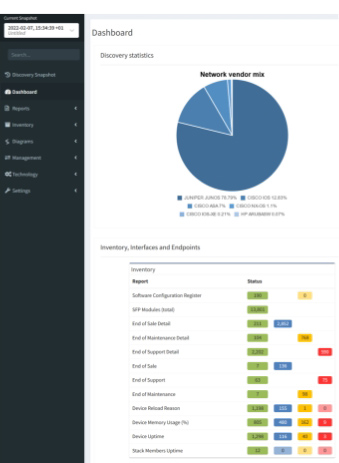

A recent Gartner prediction that more than 50% of critical business initiatives will utilize cloud platforms by 2027 seems more likely by the day. Cloud is here to stay, and it's going to become an integral part of network management. Despite this, there are still causes for concern when investing in, and implementing cloud solutions - ranging from the rising complexity associated with introducing multi-cloud into an existing network environment through to potential spending waste.
What are some of the prevalent issues that prevent organizations from getting their money's worth from the cloud? How can IP Fabric help?
Adding cloud structures to an existing on-premises network environment increases the overall complexity of said environment. Implementing different cloud vendors, ensuring interconnectivity, and trying to establish visibility that isn't really just a fragmented collection of network information masquerading as true visibility is no easy feat.
A lack of unified overview of the entire network + increased network complexity = a laundry list of visibility and complexity-based issues.
PWC's 2023 Global Digital Trust Insights report indicates that only one in five, or 19% of participating CIOs, CISOs and CTOs are confident that they have taken the necessary steps to secure themselves against breaches in the cloud. Increasing the overall surface area of your network increases the overall potential attack surface of said network after all.
A 2023 report on the state of cloud included a survey on the top organizational cloud challenges faced by both enterprises and SMBs. 82% of enterprise organizations and 80% of SMBs cited 'managing cloud spend' as their top challenge. There are a number of factors that can contribute to cloud-related spending waste:

IP Fabric's ability to discover an entire network and establish up-to-date topologies extends into the private cloud, with analysis of AWS VPCs and Azure Vnets. So, when investing in cloud structures, there won't be any blind spots left.
This also helps battle the issue of growing complexity when factoring the cloud into your network, as these topologies can be used to analyze data flow and device behavior, letting teams identify how different elements within a network are really interacting with each other, including after changes are made.
Furthermore, the unprecedented visibility provided by IP Fabric lets teams maintain connectivity within the cloud. Intent checks can be run to ensure that connectivity issues are avoided or remedied as soon as they appear, on-demand or on-schedule. Should a technical issue occur, teams can rapidly detect whether it's on-prem or cloud-based - reducing the chance that teams play the blame game when it comes to who has to troubleshoot the issue. Less time spent troubleshooting an issue means less chance of incurring loss.
With IP Fabric, you don't need to fear that your increased network surface area means a wider area of exposure for attackers to exploit. IP Fabric scales with the network as devices, and environments, are added - including the cloud.
Where IP Fabric excels from a security perspective is in the ability to provide a clear view of segmentation implemented in an environment. This won't address all of your cloud security concerns, but it does provide confirmation regarding whether the areas of a network that have segmentation implemented are indeed protected.

You can take this even further. IP Fabric's API can be used to integrate with monitoring solutions, like Centreon, which allows for even more detailed insights into how specific devices are performing or if they're performing at all.
Based on the insights teams can take from an integrated monitoring solution, they can discover where they have orphaned resources that currently aren't in use, and can remove these from the network to limit their expenditure to only the essential, in-use elements within their cloud environments.
The shift toward the cloud is inevitable. This means that complexity and spending waste are also likely to increase in step. But with detailed network visibility and network insights provided by Network Assurance, the road to implementation can be a lot smoother than it currently is for a lot of enterprises.
If you'd like to find out how IP Fabric can help you optimize your cloud investment, feel free to try our free, self-guided demo. Prefer the personal touch? Reach out to schedule an obligation-free demo with a member of our dedicated sales team.
A recent Gartner prediction that more than 50% of critical business initiatives will utilize cloud platforms by 2027 seems more likely by the day. Cloud is here to stay, and it's going to become an integral part of network management. Despite this, there are still causes for concern when investing in, and implementing cloud solutions - ranging from the rising complexity associated with introducing multi-cloud into an existing network environment through to potential spending waste.
What are some of the prevalent issues that prevent organizations from getting their money's worth from the cloud? How can IP Fabric help?
Adding cloud structures to an existing on-premises network environment increases the overall complexity of said environment. Implementing different cloud vendors, ensuring interconnectivity, and trying to establish visibility that isn't really just a fragmented collection of network information masquerading as true visibility is no easy feat.
A lack of unified overview of the entire network + increased network complexity = a laundry list of visibility and complexity-based issues.
PWC's 2023 Global Digital Trust Insights report indicates that only one in five, or 19% of participating CIOs, CISOs and CTOs are confident that they have taken the necessary steps to secure themselves against breaches in the cloud. Increasing the overall surface area of your network increases the overall potential attack surface of said network after all.
A 2023 report on the state of cloud included a survey on the top organizational cloud challenges faced by both enterprises and SMBs. 82% of enterprise organizations and 80% of SMBs cited 'managing cloud spend' as their top challenge. There are a number of factors that can contribute to cloud-related spending waste:

IP Fabric's ability to discover an entire network and establish up-to-date topologies extends into the private cloud, with analysis of AWS VPCs and Azure Vnets. So, when investing in cloud structures, there won't be any blind spots left.
This also helps battle the issue of growing complexity when factoring the cloud into your network, as these topologies can be used to analyze data flow and device behavior, letting teams identify how different elements within a network are really interacting with each other, including after changes are made.
Furthermore, the unprecedented visibility provided by IP Fabric lets teams maintain connectivity within the cloud. Intent checks can be run to ensure that connectivity issues are avoided or remedied as soon as they appear, on-demand or on-schedule. Should a technical issue occur, teams can rapidly detect whether it's on-prem or cloud-based - reducing the chance that teams play the blame game when it comes to who has to troubleshoot the issue. Less time spent troubleshooting an issue means less chance of incurring loss.
With IP Fabric, you don't need to fear that your increased network surface area means a wider area of exposure for attackers to exploit. IP Fabric scales with the network as devices, and environments, are added - including the cloud.
Where IP Fabric excels from a security perspective is in the ability to provide a clear view of segmentation implemented in an environment. This won't address all of your cloud security concerns, but it does provide confirmation regarding whether the areas of a network that have segmentation implemented are indeed protected.

You can take this even further. IP Fabric's API can be used to integrate with monitoring solutions, like Centreon, which allows for even more detailed insights into how specific devices are performing or if they're performing at all.
Based on the insights teams can take from an integrated monitoring solution, they can discover where they have orphaned resources that currently aren't in use, and can remove these from the network to limit their expenditure to only the essential, in-use elements within their cloud environments.
The shift toward the cloud is inevitable. This means that complexity and spending waste are also likely to increase in step. But with detailed network visibility and network insights provided by Network Assurance, the road to implementation can be a lot smoother than it currently is for a lot of enterprises.
If you'd like to find out how IP Fabric can help you optimize your cloud investment, feel free to try our free, self-guided demo. Prefer the personal touch? Reach out to schedule an obligation-free demo with a member of our dedicated sales team.




